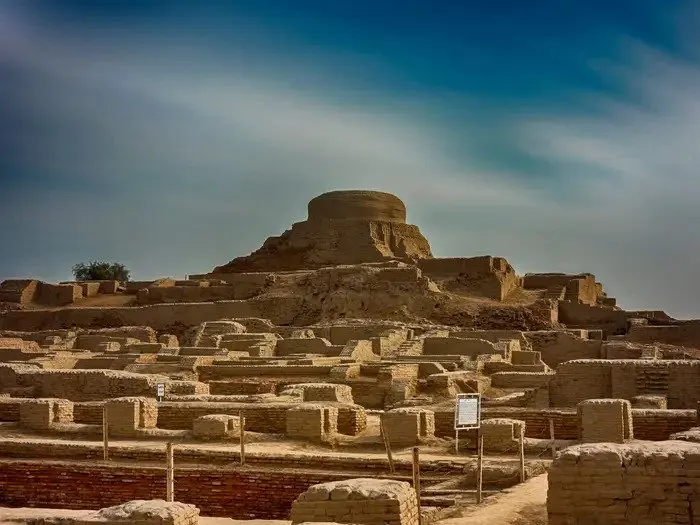Unveiling Mohenjo Daro: A Glimpse into an Ancient Civilization

Settled in the core of the Sindh region in Pakistan lies one of the most confounding and very much saved leftovers of the old world - Mohenjo Daro. This ancient city, dating back to around 2500 BCE, was a thriving center of the Indus Valley Civilization, one of the world's earliest urban cultures. Mohenjo Daro, meaning "Mound of the Dead" in Sindhi, is a testament to the ingenuity, sophistication, and mystery of a civilization that flourished long before the classical civilizations of Greece and Rome.
The Discovery of Mohenjo Daro
Mohenjo Daro was discovered in 1922 by Rakhaldas Bandyopadhyay, an officer of the Archaeological Survey of India. His discovery was not just a significant archaeological find but a revelation that challenged the existing understanding of ancient history. The excavation unveiled a city that had been meticulously planned, with a grid-like layout, advanced drainage systems, and impressive architecture. This discovery marked the beginning of a new era in the study of ancient civilizations, shedding light on a society that was remarkably advanced for its time.
Urban Planning and Architecture
One of the most striking features of Mohenjo Daro is its urban planning. The city was laid out in a well-organized grid pattern, with streets intersecting at right angles, a hallmark of sophisticated urban planning.
The city was partitioned into two fundamental parts: the Stronghold and the Lower Town.The Citadel, a raised area, housed important structures such as the Great Bath, granaries, and assembly halls. The Lower Town was a residential area where the majority of the city's inhabitants lived.
The Incomparable Shower is one of the most notorious designs of Mohenjo Daro.. This large, rectangular water tank, built of baked bricks and lined with bitumen to make it waterproof, is believed to have been used for ritual bathing. The presence of such a sophisticated structure suggests that the inhabitants of Mohenjo Daro placed significant importance on cleanliness and ritual purification.
The residential buildings of Mohenjo Daro were equally impressive. Constructed with baked bricks, these multi-story houses featured courtyards, private wells, and bathrooms. The advanced drainage system, with covered drains running along the streets and a network of underground sewers, highlights the emphasis on sanitation and public health.
The People of Mohenjo Daro

While the physical remains of Mohenjo Daro provide a glimpse into the architectural and urban achievements of the Indus Valley Civilization, they also raise intriguing questions about the people who lived there. The occupants of Mohenjo Daro were gifted craftsmans, merchants, and ranchers.. Evidence suggests that they engaged in trade with distant regions, including Mesopotamia, as indicated by the discovery of seals and artifacts with Mesopotamian motifs.
The society of Mohenjo Daro was likely diverse and complex, with a social structure that included artisans, merchants, laborers, and possibly a ruling elite. The absence of palatial structures and elaborate tombs suggests that the society might have been more egalitarian compared to contemporary civilizations like ancient Egypt and Mesopotamia.
Script and Language
One of the enduring mysteries of Mohenjo Daro is its script. The Indus script, found on numerous seals, tablets, and pottery fragments, remains undeciphered to this day. The script consists of pictorial symbols, and despite extensive efforts by linguists and archaeologists, its meaning and linguistic affiliations remain elusive. Deciphering the script could potentially unlock a wealth of information about the social, economic, and political aspects of the Indus Valley Civilization.
Decline and Abandonment

The decay and possible deserting of Mohenjo Daro is covered in secret. Around 1900 BCE, the city began to decline, and by 1700 BCE, it was largely abandoned. Various theories have been proposed to explain this decline, including climatic changes, shifting river courses, and invasions. However, none of these theories provide a definitive answer, leaving the fate of Mohenjo Daro an open question.
Legacy and Significance
The significance of Mohenjo Daro extends beyond its historical and archaeological value. It represents a pinnacle of human achievement in urban planning, architecture, and social organization during the Bronze Age. The city’s advanced infrastructure, including its drainage and sanitation systems, reflects a level of civic management that was unparalleled in the ancient world.
Moreover, Mohenjo Daro is a reminder of the interconnectedness of ancient civilizations. The trade links with Mesopotamia and possibly other regions highlight the extensive network of interactions that existed thousands of years ago, challenging the notion of isolated ancient cultures.
Preservation Challenges
Preserving Mohenjo Daro poses significant challenges. The site is vulnerable to environmental threats, including flooding, salinity, and erosion. Additionally, human activities, such as agricultural encroachment and tourism, put further pressure on the fragile ruins. International and local efforts are ongoing to protect and conserve this invaluable heritage site, ensuring that future generations can continue to marvel at its splendor.
Conclusion
Mohenjo Daro remains as a demonstration of the creativity and complexity of the Indus Valley Human progress. Its very much arranged roads, high level seepage frameworks, and noteworthy design uncover a general public that was surprisingly cutting-edge for now is the right time.While many mysteries remain, including the undeciphered script and the reasons for its decline, Mohenjo Daro continues to captivate the imagination of historians, archaeologists, and the general public.
In studying Mohenjo Daro, we gain not only insights into an ancient civilization but also a deeper appreciation for the shared heritage of humanity. The city serves as a poignant reminder of the heights that human societies can achieve and the enduring legacy of our ancestors. As we continue to unravel its mysteries and strive to preserve its remains, Mohenjo Daro will undoubtedly remain a beacon of our past and a source of inspiration for the future.